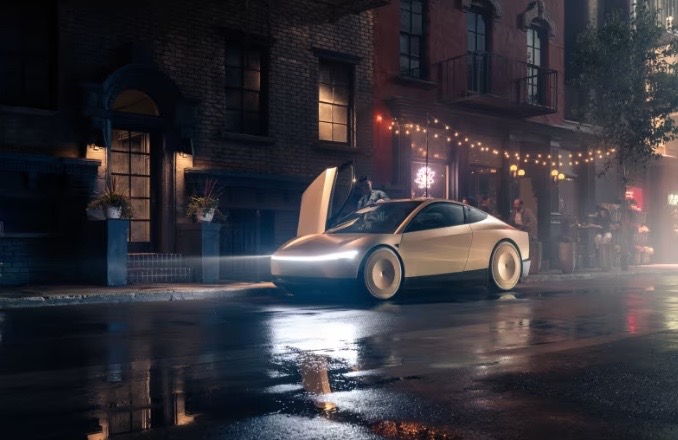
How come Tesla isn’t rolling out Cybercabs in San Francisco, Los Angeles, or Phoenix as an autonomous robotaxi service?
Is getting sued over alleged artificial intelligence-fueled copyright infringement of images from the film ‘Blade Runner 2049’ enough to stop Tesla from competing in the burgeoning robotaxi market? Probably not. That company had moved away from its long-promised entry into the robotaxi space a few months ago — which has become more obvious since the Cybercab launch event.
Tesla CEO Elon Musk, the Tesla corporation, and Warner Brothers Discovery were sued by Alcon Entertainment because the sued parties had asked for permission to use an image from the film for the Oct. 10 event launching the Cybercab at Warner Brothers Discovery’s studio lot in Burbank, California. That request was denied by Alcon. That went awry when, during the Cybercab event, an edited version of a scene from the film was shown on a presentation slide on a live stream for 11 seconds as Musk spoke.
Back in July prior to the first scheduled Cybercab media event (that got moved to Oct. 10), CEO Elon Musk kept talking about his company launching its long-awaited robotaxi service next year. That didn’t come up at the long-awaited media event on Oct. 10 at the Warner Bros. Studios in Burbank, Calif.
The audience heard all about CyberCabs having a pricetag less than $30,000 and that it will come out before 2027; and about a ‘Robovan’ that can carry up to 20 people and that will follow the CyberCab. The company also said autonomous driving will be added to its Model 3 and Model Y cars in California and Texas by next year. Attendees at the ‘We, Robot’ event also got to hear about the Optimus robot that’s still in development, and that could be available for $20,000–$30,000 and is capable of performing various tasks.
As for robotaxis in San Francisco, Los Angeles, and Phoenix, it looks like Alphabet’s Waymo company is taking the lead there. All-electric Jaguar I-PACEs is the fleet vehicle for Waymo One in these cities.
General Motor’s Cruise division has temporarily paused autonomous vehicle service in all markets while the company evaluates how to best serve its riders and the communities where they operate. In October 2023, the California Department of Motor Vehicles on Tuesday shut down its operations, describing it as an “unreasonable risk to the public” and that the company misrepresented how safe they are — after a series bad incidents in the city.
Amazon-owned Zoox held an open house in Foster City, Calif., last month to showcase its boxy-shaped autonomous vehicle. Seats face inward, as if you were riding in a carriage with doors that open on both sides. It could be more like a trolley ride than just getting space for one-or-two riders.
The startup says it will be launching autonomous rides in San Francisco in the near future; and the company has put in more than 700,000 autonomous testing miles in California and Nevada. The vehicle can go as fast as 45 mph, and it has no steering wheel and can drive in either direction. Zoox hasn’t said when it expects to rise to commercial levels with its robotaxi fleet.
There’s expectation that Uber and Lyft will play a vital role in robotaxis being rolled out to riders. Waymo recently announced that it was expanding its partnership with Uber to offer robot taxi rides in Austin, Texas, and Atlanta by 2025.
One major hurdle has been safety. The Uber test driver behind the wheel of one of the company’s self-driving cars when it hit and killed a pedestrian in 2018, got sentenced pleaded guilty to endangerment and was sentenced to three years of supervised probation last year. In April, a self-driving Tesla carrying a passenger for Uber rammed into an SUV in Las Vegas. No one was hurt seriously from the collision in a suburban neighborhood, but it raised concerns again about whether robotaxis and other autonomous vehicles are ready yet to go beyond test runs and limited rides in a small number of markets.
How EVs are doing in Europe: European Alternative Fuels Observatory (EAFO) just released it Europe market report on the EU-27 alternative fuel vehicle market. In August, battery electric vehicles (BEVs) reached a 14.48% market share in the passenger car segment, the highest in 2024 so far. Plug-in hybrid electric vehicles (PHEVs) also maintained a notable market presence with a 7.18% market share. The European market is now seeing nearly 800,000 chargers. As of September EAFO reports that it breaks out into 673,455 AC regular chargers and 118,844 DC fast chargers. That means AC is regular charging and DC is fast charging.
On Oct. 4, EU member states voted in favor of giving the European Commission the green light to put in place definitive tariffs on BEV imports from China. That can go up 35.3% placed on top of the already existing 10% tariff that had already been placed on Chinese imports to the EU. That will come into effect on Nov. 1 for a period of five years.
Funding ZEV drayage trucks: Since November 2023, the Port of Los Angeles (POLA) and the Port of Long Beach (POLB) have partnered with the California Air Resources Board (CARB) to rapidly increase deployments of zero-emission drayage trucks. California’s Hybrid and Zero-Emission Truck and Bus Voucher Incentive Project (HVIP) has funded nearly 800 drayage trucks through this state program. An initial $60 million in HVIP-stacked incentives have been fully subscribed; HVIP funds are still available, and additional Port funds may be announced later this year. For ongoing updates about available HVIP drayage funds and other types of HVIP incentives, visit californiahvip.org/funding.



